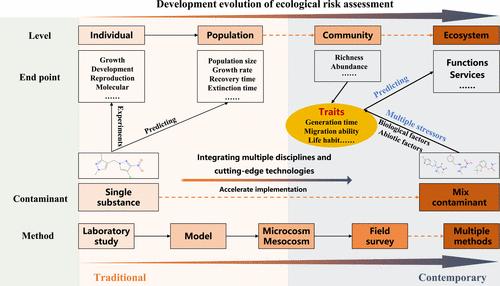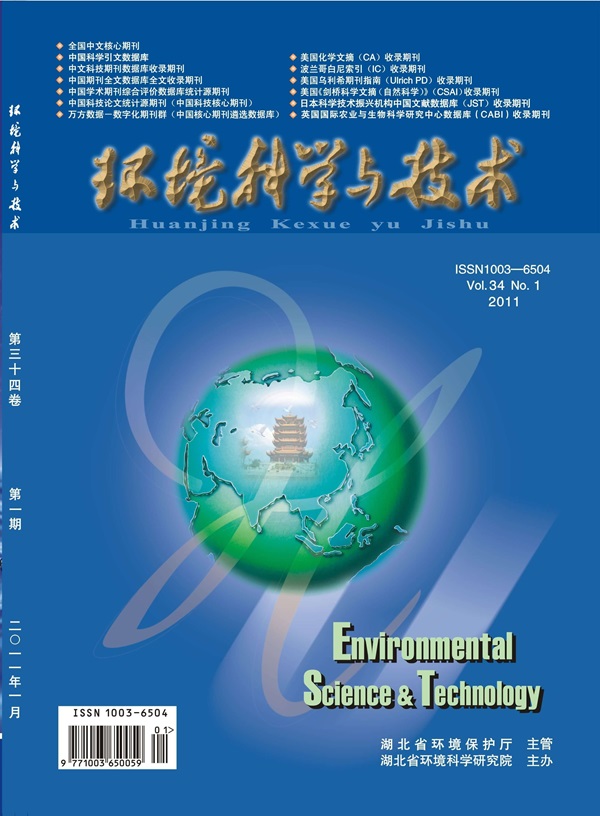Bridging the Gap: Advancing Ecological Risk Assessment from Laboratory Predictions to Ecosystem Reality
IF 10.8
1区 环境科学与生态学
Q1 ENGINEERING, ENVIRONMENTAL
引用次数: 0
Abstract
The evolution of ecological risk assessment (ERA) for contaminants has been a topic that has continued to evolve over the past 30 years, but it is important to ask ourselves whether it remains up to date. Initially, the process focused on sub-individual end points; ERA has since expanded to encompass landscape-level analyses. After focusing entirely on single substances, we now recognize the reality of exposure to contaminant mixtures. Assessment techniques have progressed from a simplistic risk quotient method to more sophisticated probabilistic approaches as the library of chemical monitoring and toxicity test data has expanded. The probabilistic approaches, where they can be applied, have reduced uncertainty, yet the link to real outcomes in the field is rarely established. (1) Traditional ERA approaches rely heavily on laboratory-derived exposure and toxicity data for a limited number of individual species, while study of the complex interactions present in natural ecosystems remains rare. These interactions include species–species and species–multiple stressor dynamics (as well as compensating factors), population-level processes such as density dependence and recovery, and ecosystem-level feedback. The outcome for wildlife from the interactions of multiple contaminants in the environment, along with various abiotic and biotic factors, is not taken into account by traditional methods. Consequently, existing methods fail to capture the full spectrum of ecological risks and threats at the ecosystem level, potentially compromising ecosystem security and functional continuity. Conversely, the traditional approaches may overestimate risks due to not taking into account animal behavior or compensating factors. Trait-based approaches offer a promising new direction for stress response and risk assessment at the community scale. (2) Introducing ecological characteristics theory within community ecology into ecological risk assessment, based on toxicity data, may more accurately predict the impact on ecosystems and their functions. By considering impacts on individual organisms to broader community dynamics, these approaches can enhance the mechanistic understanding and diagnostic capabilities of ERA. Future developments may involve combining functional traits of sensitive taxa with real environmental stressors to establish trait-based response indicators for specific contaminants. This could facilitate the construction of community-level safety thresholds for more environmentally relevant ecological risk assessments. While some progress has been made in this area, many significant challenges remain, particularly in developing comprehensive taxonomic trait databases for regions outside Europe and North America and in establishing robust mechanistic relationships between traits and stressors. (3) The implementation of more realistic ERA necessitates the integration of multiple disciplines and cutting-edge technologies. Advancements in analytical chemistry and molecular biology offer novel tools for assessing ecological risk with unprecedented precision. Environmental DNA (eDNA) technology based on high-throughput sequencing demonstrates significant potential for rapid and efficient biodiversity monitoring. (4) Trait-based approaches enhance our understanding of the responses of species to environmental stressors, and when combined with trait databases, they provide valuable insights into sensitive taxa and associated traits. eDNA approaches provide efficient tools for evaluating the effects of chemical pollutants on (1) the occurrences and population of wildlife, (2) communities, and (3) the function of an ecosystem in the field. (4) The application of eDNA technology can improve the relevance and immediacy of laboratory toxicological assessment and provide strong scientific support for ecosystem management and protection. While nontargeted screening techniques can detect a broader spectrum of contaminants, their qualitative or semiquantitative nature limits direct application in quantitative ERA. Combining nontargeted screening with targeted quantitative analysis of numerous chemicals provides a more comprehensive understanding of contaminant mixtures and their potential effects. In addition to applying toxicity data to assess the environmental impact of pollutants, we can establish a nonlinear relationship between the contaminant concentration and organism traits, accounting for the combined effects of other biological or abiotic stressors. The integration of quantitative chemical analysis and eDNA data may accelerate the convergence of predictive risk assessment and biomonitoring, potentially enabling more accurate assessments of contaminant impacts on biodiversity, community structure, and ecosystem function. Nevertheless, establishing quantitative relationships between contaminant concentrations and changes in species biodiversity remains challenging and requires continued research efforts. Advanced mathematical modeling and machine learning techniques offer promising avenues for predicting higher-level ecological responses using readily available underlying data, such as individual-level and molecular-level information. The synergistic utilization of these advanced technologies from analytical chemistry and ecology, coupled with machine learning approaches, could catalyze a paradigm shift in the reliability of comprehensive ecosystem assessment and management. (5) In conclusion, “trait-based community-level risk assessment” represents a promising paradigm for future ERA (Figure 1). By incorporating the traits of sensitive taxa and considering multiple biological and abiotic factors, this approach can enhance the mechanistic understanding and diagnostic capabilities of ERA. The integration of trait-based ERA with quantitative chemical analysis and eDNA technology offers new perspectives for ERA at the ecosystem level. While challenges remain in developing comprehensive trait databases and establishing robust mechanistic relationships between traits and stressors, continued research in this direction could lead to community-level ecological risk thresholds that more accurately reflect real environmental conditions. This holistic approach has the potential to provide a more sound basis for aquatic ecosystem protection and environmental management, effectively bridging the gap between laboratory predictions and ecosystem reality. Figure 1. Trait-based ecological risk assessment framework for natural ecosystems. X.J. and L.H. contributed equally to this work. Dr. Fengchang Wu is the director of the State Key Laboratory of Environmental Criteria and Risk Assessment, Chinese Research Academy of Environmental Sciences (CRAES). His research interests mainly cover environmental toxicology and chemistry by multidisciplinary approaches, including environmental biogeochemistry, chemistry, toxicology, and risk assessment. He has made remarkable contributions to the protection of the aquatic ecosystem in China through his advancement of environmental science, standards, technologies, and engineering. Dr. Wu was elected as an academician of the Chinese Academy of Engineering in 2017 in recognition of his work in the development of the system of environmental criteria and standards in China. This work was funded by the National Natural Science Foundation of China (42322710 and 42477299) and the National Key Research and Development Program of China (2021YFC3200105). This article references 5 other publications. This article has not yet been cited by other publications.

缩小差距:推动生态风险评估从实验室预测走向生态系统现实
先进的数学建模和机器学习技术为利用现成的基础数据(如个体层面和分子层面的信息)预测更高层次的生态响应提供了前景广阔的途径。这些来自分析化学和生态学的先进技术与机器学习方法的协同利用,可促进全面生态系统评估和管理可靠性的范式转变。(5) 总之,"基于性状的群落级风险评估 "是未来 ERA 的一种有前途的范式(图 1)。通过纳入敏感类群的性状并考虑多种生物和非生物因素,这种方法可增强对 ERA 的机理理解和诊断能力。将基于性状的 ERA 与定量化学分析和 eDNA 技术相结合,为生态系统层面的 ERA 提供了新的视角。虽然在开发综合性状数据库和建立性状与应激源之间稳健的机理关系方面仍存在挑战,但在这一方向上的持续研究可导致更准确地反映真实环境条件的群落级生态风险阈值。这种综合方法有可能为水生生态系统保护和环境管理提供更坚实的基础,有效弥合实验室预测与生态系统现实之间的差距。图 1.基于性状的自然生态系统生态风险评估框架。X.J. 和 L.H. 对本研究做出了同样的贡献。吴凤昌博士是中国环境科学研究院环境标准与风险评估国家重点实验室主任。他的研究兴趣主要涉及环境毒理学和化学,包括环境生物地球化学、化学、毒理学和风险评估等多学科方法。他通过推动环境科学、标准、技术和工程的发展,为保护中国的水生生态系统做出了卓越贡献。吴博士于 2017 年当选为中国工程院院士,以表彰他在中国环境标准体系建设方面所做的工作。这项工作得到了国家自然科学基金(42322710 和 42477299)和国家重点研发计划(2021YFC3200105)的资助。本文引用了其他 5 篇文章。本文尚未被其他出版物引用。
本文章由计算机程序翻译,如有差异,请以英文原文为准。
求助全文
约1分钟内获得全文
求助全文
来源期刊

环境科学与技术
环境科学-工程:环境
CiteScore
17.50
自引率
9.60%
发文量
12359
审稿时长
2.8 months
期刊介绍:
Environmental Science & Technology (ES&T) is a co-sponsored academic and technical magazine by the Hubei Provincial Environmental Protection Bureau and the Hubei Provincial Academy of Environmental Sciences.
Environmental Science & Technology (ES&T) holds the status of Chinese core journals, scientific papers source journals of China, Chinese Science Citation Database source journals, and Chinese Academic Journal Comprehensive Evaluation Database source journals. This publication focuses on the academic field of environmental protection, featuring articles related to environmental protection and technical advancements.
 求助内容:
求助内容: 应助结果提醒方式:
应助结果提醒方式:


